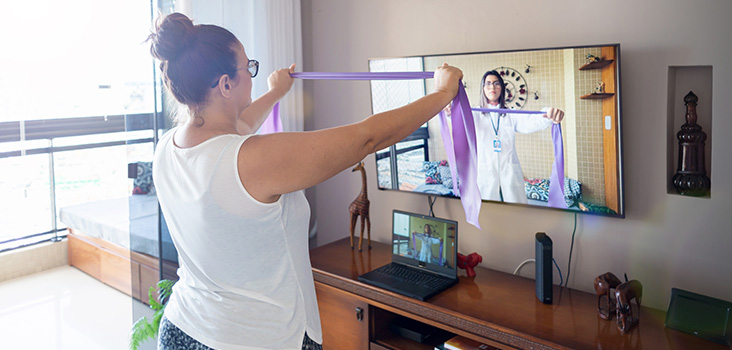
Three Ways Technology Has Improved Physical Therapy Treatment
As technology has continued to evolve, so have the ways we use it. The health care industry is no exception, and physical therapists have taken advantage of technological advancements to improve the way patients are treated.
From gamification to virtual care, physical therapy has used technology to make treatment more convenient, engaging, impactful, and fun. Here are three technological advancements that physical therapy has used to enrich the patient experience.
Wii-Hab
Wii-Hab – or physical rehabilitation using the Nintendo Wii – “gamifies” physical therapy exercises, adding some fun and competition to treatment. With the Wii’s motion-sensitive controllers, patients can play games like bowling and boxing that require repetitive movements similar to the exercises they’d complete in physical therapy.
Although the exercises are similar, participation and engagement increase when patients use the Wii. In a Johns Hopkins study, researchers incorporated Wii games into 22 patients’ physical therapy sessions. The patients said that they enjoyed the challenge of the games and the change of pace in their exercises. Because the exercises are in a game format, Wii-Hab creates an inner competitiveness that drives patients to perform better.
This enjoyment and competitiveness also encourages patients to complete their home exercise programs. If they have a Wii at home, patients are more likely to be engaged in their recovery.
Virtual Reality
Virtual reality (VR) creates an interactive, immersive, computer-generated world that allows you to experience something that isn’t physically there. This technology has been used for entertainment, training, tours, and now physical therapy.
Virtual reality provides a more engaging environment for patients to complete their physical therapy exercises. Instead of walking around a clinic, patients can walk down an outdoor path with a finish line in the distance. There can also be interactive gaming elements included in the VR experience, adding a more immersive environment to the Wii-Hab strategy. Blending the engaging environment with the gaming aspects helps challenge patients to develop new strategies for balance, coordination, and mobility. Therapists and organizations are continuing to find new ways to use virtual reality for physical therapy.
A therapist in New York, Dr. Lev Kalika, has used VR to treat patients recovering from stroke, injury, or surgery who have back pain, walking disorders, and orthopedic and neurological issues. He’s found that the virtual environment helps speed up the learning process by teaching patients to replace previous movement strategies with new techniques.
The University of South Florida is using the same virtual reality technology used by the Department of Defense to study how VR can help patients who have disabilities or have suffered strokes or traumatic injuries. The VR system – called CAREN (Computer Assisted Rehabilitation Environment) – will help improve the ability to diagnose and treat musculoskeletal and neurological disorders.
Tele-Rehab
Telemedicine has been an important development for the health care industry. With the ability to access care on demand, patients are more likely to see a doctor when they need to, and there’s a higher likelihood that patients will complete their treatment plans. Thanks to tele-rehabilitation services, these benefits are also found with physical therapy.
The Centers for Disease Control and Prevention (CDC) reports that more than 700,000 people receive knee replacements each year, but almost 70% of those patients don’t complete their post-surgery physical therapy. Patients might be discouraged by having to drive to their appointment, how much time they think therapy will take, or even from fear about doing physical therapy in general. But not completing the treatment process can lead to more serious complications, like chronic pain or hospital readmissions.
Physical therapy through telemedicine can help reduce a lot of these fears and encourage patients to complete their exercises. Visiting a therapist from the comfort of their home removes the commute and helps patients feel more at ease. Through the telemedicine platform, physical therapists can walk patients through the process, show them how to complete certain exercises, watch to make sure the patient is doing the exercises correctly, and prescribe a home exercise program.
Whether through technological or scientific advancements, physical therapy is always seeking new ways to improve treatment for patients. These technology platforms have made therapy more convenient and engaging for patients, encouraging them to complete treatment and experience a fuller recovery.
At Concentra, we follow evidence-based practices in our treatment, so our physical therapists use an active, functional-focused treatment plan. These practices are proven to result in a faster, fuller recovery, saving you time and money in the process. Learn more about why Concentra advocates for physical therapy in our idea paper, The Power of Physical Therapy.



